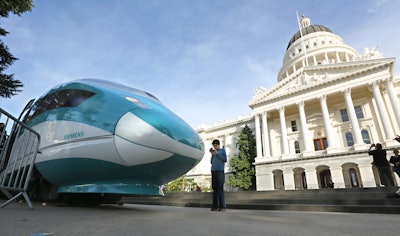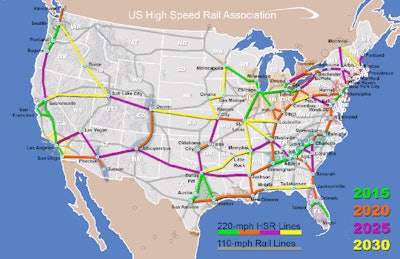
America doesn’t seem to feel the need for speed — at least on the rails. Although Europe and Asia have built a transportation infrastructure full of bullet trains that travel at hundreds of miles an hour, America’s passenger rail system is dominated by Amtrak’s slow-chugging, outdated carriages that fail to rival air travel in time or cost.
Why exactly is that? Do we just love our cars and airplanes too much? Is converting to high-speed tracks too expensive? Is America too vast and spread out to benefit? Is there no political will?
Although these answers are the usual suspects, Andy Kunz, president of the U.S. High Speed Rail Association, says there’s a bigger roadblock: the lobbying efforts of major industries including big oil, big aviation and big highway.
“Every time someone tries to move forward [with high speed rail], they stomp all over them,” Kunz says. “It’s pretty powerful.”
To be fair, Kunz is himself a lobbyist of sorts. His vision is to see America connected by bullet trains from coast to coast. When hearing his passion, I dare you to not be, at least momentarily, persuaded that it would be a major upgrade from our current situation.
The way Kunz tells it, his small association is in a David vs. Goliath situation — up against “think tanks” like the Cato Institute, which is supported by Republican politicians who are funded by the Koch brothers.
 (AP Photo)
(AP Photo)Like nearly everything in politics, it’s become a partisan issue and typically boils down to cost.
If you believe Kunz, high-speed rail will boost economic development, increase jobs through the supply chain, curb fossil fuel emissions and make travel easier and more enjoyable. Despite being expensive to build — which is why they are generally built with government backing — a high-speed rail network can also bring in loads of money to the government, which Kunz says happens every year in Spain.
Of course, not everyone agrees that Spain’s high-speed system has been a profitable boom for the economy, and many in the country have expressed buyer’s remorse. Japan’s system — which is not as heavily subsidized as Western Europe’s — seems to have fared better in the private market.
The private sector is exactly how it should be paid for, according to the Cato Institute and many Republicans. If there’s no interest from private companies, they argue government shouldn’t foot the bill.
So that’s the why there’s still no high-speed rail. But how about the where are we now? And the what next? Will the rest of the developed world keep whizzing past while America drags its feet?
Here’s a look at where tracks are being laid across the country and another emerging issue: whether or not that light at the end of the tunnel for high-speed rail could just be an oncoming Hyperloop train.
 (Image credit: U.S. High Speed Rail Association)
(Image credit: U.S. High Speed Rail Association)Full Speed Ahead In California And Florida
In 2009 Obama launched an ambitious program to begin building a high-speed rail network in the U.S. to which Congress appropriated $10.5 billion. Some of the money is being used to upgrade existing tracks to allow slightly faster travel, while other states that could construct high-speed rail were considered for major funding. Several Republican-led states including Wisconsin, Ohio and Florida ultimately rejected the funds. But their loss was California’s gain.
With funds from the other states, California committed to building a $68 billion high-speed line that is funded by the feds, the state and the private sector.
The train will run from San Francisco to Los Angeles at speeds reaching 200 mph with stops at 24 stations. Construction has just begun on the project, and it is slated to begin running by 2029.
But 2029 is a long way off with many election cycles to come, and Kunz admits that, however unlikely at this point, there’s still a chance the project could be derailed by an unsupportive political climate.
Meanwhile in Florida, despite Republicans blocking federal dollars for a high-speed rail project, a privately funded higher-speed rail project will soon link Miami and Orlando. Called All Aboard Florida, the $3 billion train will travel at a modest speed of 81 mph (true “high-speed” rail is typically consider to be more than 155 mph). When it opens in 2017 the rail will be the first time a privately owned company has developed and opened a train line in the U.S. in more than 100 years.
Progress Everywhere Is Piecemeal
As the fallout from Obama’s plan shows, even with a strong federal push for change, it’s still up to states to take the ball and roll with it and — if they don’t — plans will stall.
In the absence of a cohesive national plan, America isn’t likely to end up with one system, but instead a network of smaller systems funded from various sources that might eventually link together.
The U.S. High Speed Rail Association has released the following map showing what that network could look like and when these lines could (in a dream scenario) be completed.
 (AP Photo)
(AP Photo)Foreign Companies Could Cash In
While America sits on its hands, foreign companies are cashing in. Most notably, China and Japan are in a global completion to land rail projects in several countries, including the U.S.
Last year, China Railway International, a consortium led by the Chinese national railroad, announced that it was providing a $100 million capital investment to what could become America’s first operating high-speed rail line between Los Angeles and Las Vegas.
In Texas, a private U.S. company is planning a $10 billion high-speed system that will whisk passengers from Dallas to Houston in less than 90 minutes. The line will employ a fleet of Japanese bullet trains that reach speeds near 205 mph.
A New Generation Could Tip Public Opinion
According to Kunz, millennials are ditching car culture in favor of an urban lifestyle.
“Back in the ‘50s everyone was moving to the suburbs,” Kunz says. “Now that’s going the other direction. Big developers have scrapped endless single family home projects and are building urban. That all lends itself to a rail, walking culture.”
Recently reports surfaced showing that millennials are finally buying cars at a higher rate. But public support seems to be increasing for high-speed rail. One recent study revealed that around two-thirds of Americans say they’d use high-speed rail if it was available. As support grows, it could build pressure for more politicians to also get on board.
 One proposed design for the hyperloop. (Image via AP)
One proposed design for the hyperloop. (Image via AP)The Hyperloop Factor
Elon Musk recently promised that his Hyperloop idea will one day transport people from Los Angeles to San Francisco in 36 minutes for a $30 ticket.
In the past few years, the race has been on to get a Hyperloop prototype track up and running at several sites. The proposed technology has yet to be tested on a real-life scale but promises to shoot passengers down a tube at hyper speeds using a magnetic force. If engineers can pull it off, the Hyperloop would undeniably revolutionize travel.
But there are plenty of concerns about whether or not the near-vacuum conditions can be maintained across climates, if it will be a “terrifying barf ride,” and if it will be safe and truly cost effective.
Kunz is one such doubter and isn’t worried that the Hyperloop will come along and suddenly render high-speed rail obsolete.
“I don’t think Hyperloop is ever going to be real,” he said. “It’s too experimental. We’re all for innovation, but we’re for what we can put into place today, not 40 years from now.”
Read more:
From the Cato Institute: "Why Can't We Have Great Trains? Because We Don't Want Them"
From the US High Speed Rail Association: "10 Top Myths About High Speed Rail"


















